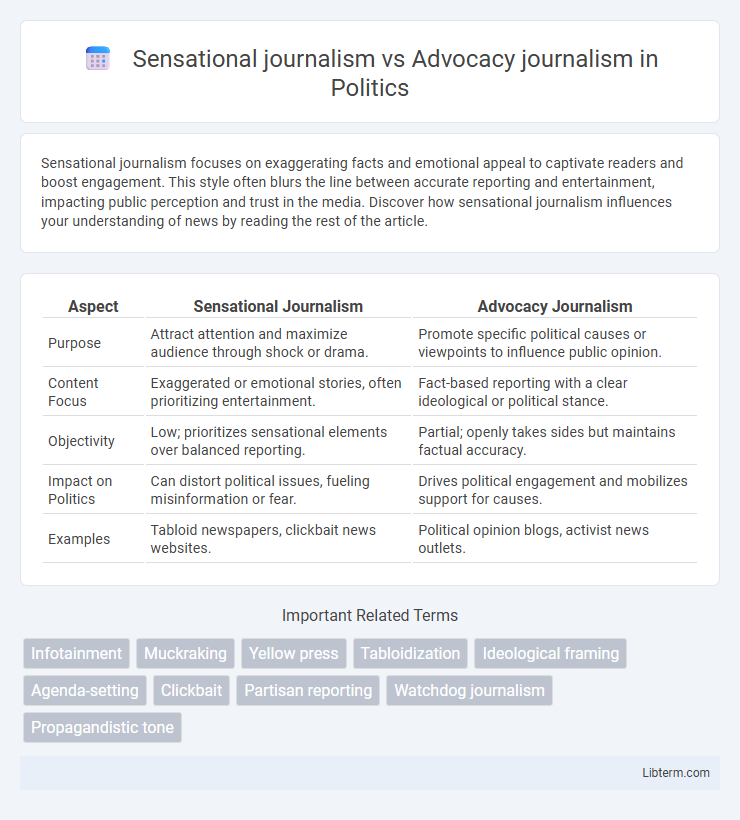Sensational journalism focuses on exaggerating facts and emotional appeal to captivate readers and boost engagement. This style often blurs the line between accurate reporting and entertainment, impacting public perception and trust in the media. Discover how sensational journalism influences your understanding of news by reading the rest of the article.
Table of Comparison
| Aspect | Sensational Journalism | Advocacy Journalism |
|---|---|---|
| Purpose | Attract attention and maximize audience through shock or drama. | Promote specific political causes or viewpoints to influence public opinion. |
| Content Focus | Exaggerated or emotional stories, often prioritizing entertainment. | Fact-based reporting with a clear ideological or political stance. |
| Objectivity | Low; prioritizes sensational elements over balanced reporting. | Partial; openly takes sides but maintains factual accuracy. |
| Impact on Politics | Can distort political issues, fueling misinformation or fear. | Drives political engagement and mobilizes support for causes. |
| Examples | Tabloid newspapers, clickbait news websites. | Political opinion blogs, activist news outlets. |
Introduction to Sensational Journalism and Advocacy Journalism
Sensational journalism emphasizes eye-catching headlines, emotional stories, and dramatic visuals to captivate audiences and boost readership. Advocacy journalism supports specific political or social causes, aiming to promote change by presenting facts through a biased lens aligned with its agenda. Both forms diverge from traditional objective reporting by prioritizing emotional impact or ideological persuasion over neutrality.
Key Characteristics of Sensational Journalism
Sensational journalism prioritizes eye-catching headlines, vivid imagery, and emotional appeals to attract immediate attention and maximize readership. It often exaggerates facts, emphasizes scandal, and simplifies complex issues to provoke strong reactions and sustain public interest. This style relies heavily on shock value and controversy rather than in-depth analysis or balanced reporting.
Key Characteristics of Advocacy Journalism
Advocacy journalism emphasizes a clear stance on social or political issues, prioritizing truth-telling and transparency while actively promoting change. Unlike sensational journalism, which seeks to attract attention through exaggerated or provocative content, advocacy journalism relies on thorough research, factual accuracy, and persuasive storytelling to influence public opinion. Key characteristics include commitment to ethical standards, highlighting underrepresented perspectives, and fostering public dialogue to support justice and accountability.
Historical Evolution of Both Journalism Styles
Sensational journalism emerged in the late 19th century, characterized by exaggerated headlines and emotional appeal designed to capture mass readership during the rise of mass media and urbanization. Advocacy journalism developed alongside, particularly gaining momentum in the early 20th century, focusing on promoting social change and representing marginalized voices, influenced by progressive political movements. Both styles reflect evolving media landscapes and societal demands, with sensational journalism prioritizing entertainment value and advocacy journalism emphasizing ethical responsibility and activism.
Impact on Public Perception and Trust
Sensational journalism often distorts facts by emphasizing shock value, leading to heightened emotional reactions but eroding public trust due to perceived bias and misinformation. Advocacy journalism advocates particular viewpoints, which can deepen public understanding of specific issues but may also polarize audiences and diminish perceived objectivity. Both approaches significantly influence public perception, shaping how audiences evaluate credibility and reliability in news sources.
Ethical Considerations and Controversies
Sensational journalism often prioritizes emotional appeal and shock value, sometimes compromising accuracy and ethical standards to attract readership. Advocacy journalism, while maintaining a commitment to truth, openly promotes a particular viewpoint or social cause, raising concerns about bias and objectivity in reporting. Ethical controversies arise when sensationalism distorts facts for profit, whereas advocacy journalism faces scrutiny over whether its persuasive goals overshadow balanced news coverage.
Case Studies: Real-world Examples
Sensational journalism often prioritizes emotional impact and dramatic headlines, as seen in the 2016 coverage of the Panama Papers, where media outlets highlighted scandalous revelations to attract viewership. Advocacy journalism, exemplified by The Guardian's environmental reporting, focuses on promoting social change through in-depth analysis and factual accuracy. Both approaches influence public opinion, but advocacy journalism tends to drive policy debates, while sensational journalism aims at immediate audience engagement.
Influence on Media Policies and Regulations
Sensational journalism often prompts stricter media policies and regulations due to its focus on exaggeration and emotional appeal, raising concerns over misinformation and ethical standards. Advocacy journalism influences media policies by promoting transparency and encouraging reforms that support diverse, marginalized voices while pushing for accountability in reporting. Both journalistic approaches shape regulatory frameworks by highlighting the balance between freedom of expression and the need for responsible, accurate news dissemination.
Public Response and Societal Consequences
Sensational journalism often triggers immediate emotional reactions, leading to widespread public panic or outrage, while advocacy journalism mobilizes targeted audiences around specific social or political causes, fostering engaged activism. The public response to sensationalism can result in misinformation and heightened distrust in media, whereas advocacy journalism promotes informed debates and community involvement. Societal consequences of sensational journalism include polarization and erosion of public trust, contrasted by advocacy journalism's role in driving social change and policy reform.
The Future of Journalism: Sensationalism vs. Advocacy
Sensational journalism prioritizes eye-catching headlines and emotional appeal to attract immediate attention, often sacrificing depth and accuracy, while advocacy journalism emphasizes promoting social causes and influencing public opinion through well-researched narratives. The future of journalism hinges on balancing sensationalism's audience engagement with advocacy's commitment to ethical storytelling and social responsibility. Emerging digital platforms increasingly favor advocacy journalism's transparency and authenticity, shaping a media landscape that demands accountability and meaningful content.
Sensational journalism Infographic

 libterm.com
libterm.com